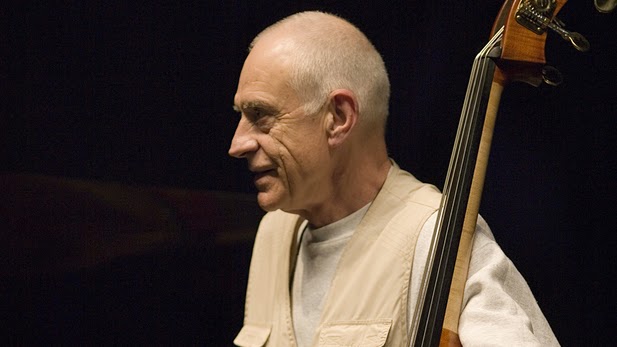Paul Motian has been a constant and essential feature of the American jazz scene for many years. From his early days as drummer with the Bill Evans Trio through to the mid period of his career, as one third of the Paul Motian Trio he has constantly shown touch and perception in his choice of material and playing partners.
This album, Bill Evans: Tribute to the Great Post-Bop Pianist, recorded in 1990 on Winter & Winter, when he was approaching his sixtieth birthday marks perhaps a highlight in a career that has many highlights. Drawing on the material of the legendary pianist and melodist, Bill Evans, he has, together with his trio partners, Bill Frisell and Joe Lovano plus bassist Marc Johnson created an album that is excellent and at times sublime.
Given the high standards of playing this group of musicians has been responsible for over the years, and the unforgettable and haunting melodies of Bill Evans it is hard to see where this recording could have gone wrong. But what is truly remarkable is that all four musicians have found ways of expanding their past powers of interpretation and unearthed in these nine Evans tunes harmonic possibilities, rhythmic interplay and originality of voice that in the hands of lesser musicians could have resulted in a more subdued tribute. Perhaps Motian’s personal experience of playing with Evans brought an element to the sessions that prevented it from simply treading water as the work of four fans.
This album, Bill Evans: Tribute to the Great Post-Bop Pianist, recorded in 1990 on Winter & Winter, when he was approaching his sixtieth birthday marks perhaps a highlight in a career that has many highlights. Drawing on the material of the legendary pianist and melodist, Bill Evans, he has, together with his trio partners, Bill Frisell and Joe Lovano plus bassist Marc Johnson created an album that is excellent and at times sublime.
Given the high standards of playing this group of musicians has been responsible for over the years, and the unforgettable and haunting melodies of Bill Evans it is hard to see where this recording could have gone wrong. But what is truly remarkable is that all four musicians have found ways of expanding their past powers of interpretation and unearthed in these nine Evans tunes harmonic possibilities, rhythmic interplay and originality of voice that in the hands of lesser musicians could have resulted in a more subdued tribute. Perhaps Motian’s personal experience of playing with Evans brought an element to the sessions that prevented it from simply treading water as the work of four fans.
The only real problem must have been deciding on which Evans songs not to include. There are no real highlights here, as each track is played with such excellence and sensitivity they all stand out. It would be better perhaps to name my favourites. An absolute contender has to be "Turn out the Stars," with Joe Lovano floating lovely feathery and melancholy tenor sax over Paul Motian’s ever thoughtful drum and brush work. Bill Frisell’s curious, at times bluesy guitar shapes and Marc Johnson’s bass work off the percussion with a bounce and swinging touch
"Time Remembered" also stands out. The minor figures, and the melody’s downward pull are interpreted with emphasis on its spaces, and its sense of loss. The drum and brush work add a fluid, almost liquid quality, with a splash of cymbal here, and a rhythmic phrase rising like a wave only to subside again. Again Bill Frisell pulls shapes and lines from his fretboard that have a feel of the blues, as well as conventional jazz, and at times even a hint of country-western (a genre he would later explore). Marc Johnson walks and steps though the melody, with a solo that finds its hidden harmonics. And Lovano’s tenor sax is perfectly pitched, sweet without being saccharine, expressive without being intrusive.
There are other wonderful tracks. "Re: Person I knew," (what a great title), is played with an engaging and wistful nonchalance. "Very Early" simply swings. "Five" features the most experimental, distorted guitar and passages of free-jazz, while "34. Skidoo," is a playful and uplifting number.
This is an excellent and essential recording. It shows four musicians at their best. The level of interplay and communication is never short of exquisite. It is a worthy tribute to a great musician, and a fitting example of four great musicians playing music that is unforgettable and inspiring. Highly recommended. - David Millington
There are other wonderful tracks. "Re: Person I knew," (what a great title), is played with an engaging and wistful nonchalance. "Very Early" simply swings. "Five" features the most experimental, distorted guitar and passages of free-jazz, while "34. Skidoo," is a playful and uplifting number.
This is an excellent and essential recording. It shows four musicians at their best. The level of interplay and communication is never short of exquisite. It is a worthy tribute to a great musician, and a fitting example of four great musicians playing music that is unforgettable and inspiring. Highly recommended. - David Millington
Tracks
1. Show-Type Tune
2. Turn Out The Stars
3. Walkin' Up
4. Very Early
5. Five
6. Time Remembered
7. 34 Skidoo
8. Re: Person I Knew
9. Children's Play Song
PAUL MOTIAN drums
BILL FRISELL guitar
JOE LOVANO tenor saxophone
MARC JOHNSON bass
All compositions by Bill Evans
Recorded at Sorcerer Sound NYC, May 1990
JMT 834 445 - 2
1. Show-Type Tune
2. Turn Out The Stars
3. Walkin' Up
4. Very Early
5. Five
6. Time Remembered
7. 34 Skidoo
8. Re: Person I Knew
9. Children's Play Song
PAUL MOTIAN drums
BILL FRISELL guitar
JOE LOVANO tenor saxophone
MARC JOHNSON bass
All compositions by Bill Evans
Recorded at Sorcerer Sound NYC, May 1990
JMT 834 445 - 2
























































